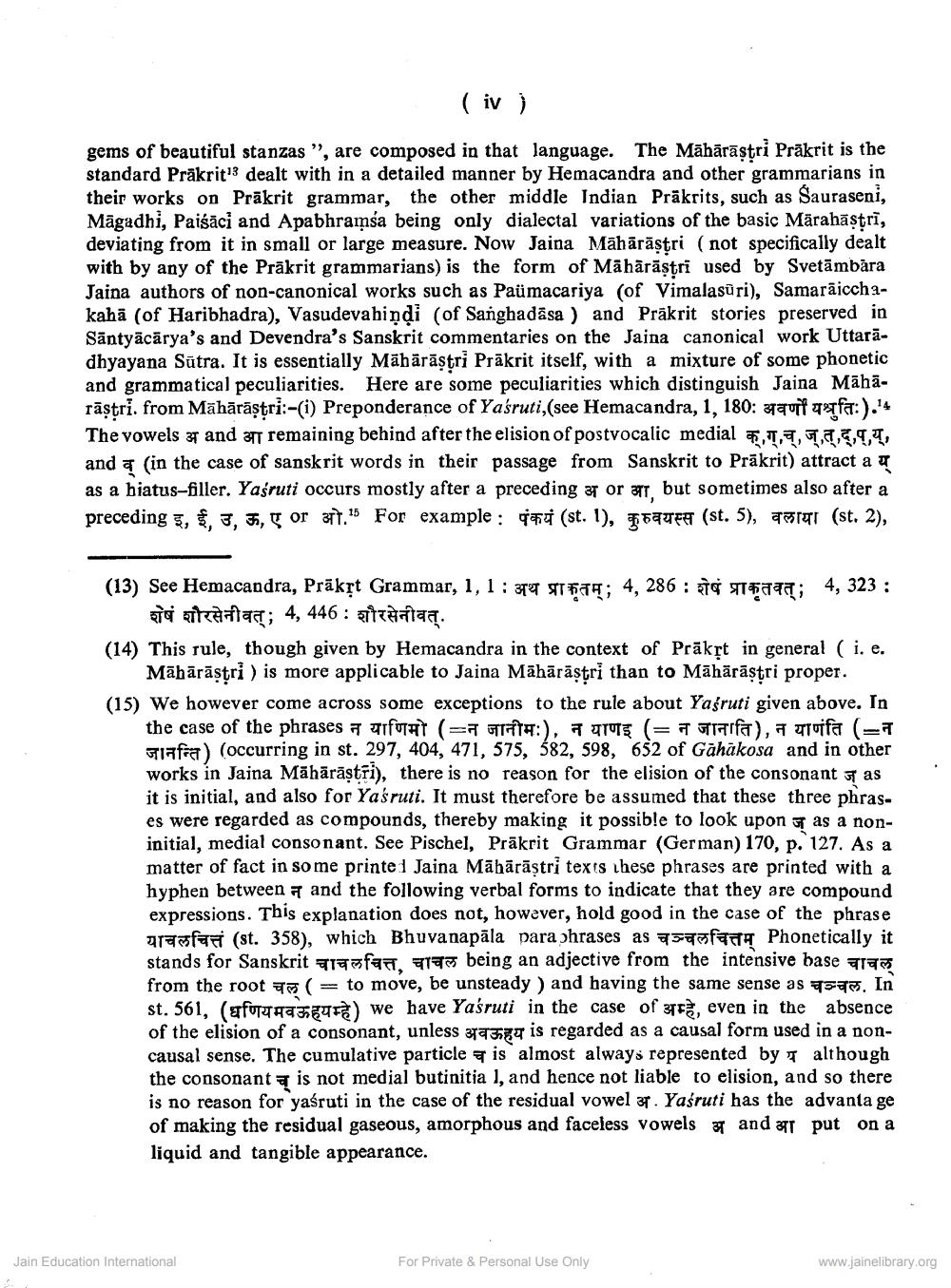________________
(iv)
gems of beautiful stanzas", are composed in that language. The Māhārāstri Präkrit is the standard Prākrit" dealt with in a detailed manner by Hemacandra and other grammarians in their works on Prākrit grammar, the other middle Indian Prakrits, such as Sauraseni, Māgadhi, Paisāci and Apabhraņsa being only dialectal variations of the basic Mārahāstrī, deviating from it in small or large measure. Now Jaina Māhārāştri (not specifically dealt with by any of the Prākrit grammarians) is the form of Māhārāștri used by Svetāmbara Jaina authors of non-canonical works such as Paümacariya (of Vimalasūri), Samarāicchakahā (of Haribhadra), Vasudevabindi (of Sanghadāsa) and Prākrit stories preserved in Sāntyācārya's and Devendra's Sanskrit commentaries on the Jaina canonical work Uttaradhyayana Sūtra. It is essentially Māhārāştri Prākrit itself, with a mixture of some phonetic and grammatical peculiarities. Here are some peculiarities which distinguish Jaina Māhārāștri. from Māhārāștri:-(i) Preponderance of Yasruti,(see Hemacandra, 1, 180: zauf tafa:).14 Thevowels a and आ remaining behind after the elision of postvocalic medial क,ग,च, जत्द् ,पाय, and a (in the case of sanskrit words in their passage from Sanskrit to Prākrit) attract all as a hiatus-filler. Yašruti occurs mostly after a preceding 3 or at, but sometimes also after a preceding , S. 3, 5, T or 31.15 For example : 1 (st. 1), 5U (st. 5), T T (st. 2),
es a giftat
71, 575, 582,
the elision of
(13) See Hemacandra, Prākệt Grammar, 1, 1 : 377 974; 4, 286 : 0 ST TIT; 4, 323 :
To acaat; 4, 446 : Taaraa. (14) This rule, though given by Hemacandra in the context of Prākst in general ( i. e.
Mābārāştri ) is more applicable to Jaina Māhārāştri than to Māhārāștri proper. (15) We however come across some exceptions to the rule about Yašruti given above. In
the case of the phrases 7 alfat (= HTA:), NE (= FT FTIT), etuifa ( Tiafia) (occurring in st. 297, 404, 471, 575, 582, 598, 652 of Gāhākosa and in other works in Jaina Māhārāştri), there is no reason for the elision of the consonant as it is initial, and also for Yaśruti. It must therefore be assumed that these three phrases were regarded as compounds, thereby making it possible to look upon as a noninitial, medial consonant. See Pischel, Prākrit Grammar (German) 170, p. 127. As a matter of fact in some printe 1 Jaina Māhārāştri texts these phrases are printed with a hyphen between 1 and the following verbal forms to indicate that they are compound expressions. This explanation does not, however, hold good in the case of the phrase ar fari (st. 358), which Bhuvanapāla para phrases as eft Phonetically it stands for Sanskrit चाचलचित्त. चाचल being an adjective from the intensive base चाचल from the root (= to move, be unsteady) and having the same sense as 75. In st. 561, (afta r ) we have Yaśruti in the case of F, even in the absence of the elision of a consonant, unless 377580 is regarded as a causal form used in a noncausal sense. The cumulative particle is almost always represented by T although the consonant is not medial butinitia I, and hence not liable to elision, and so there is no reason for yaśruti in the case of the residual vowel 3. Yaśruti has the advantage of making the residual gaseous, amorphous and faceless vowels 37 and ar put on a liquid and tangible appearance.
Jain Education International
For Private & Personal Use Only
www.jainelibrary.org




